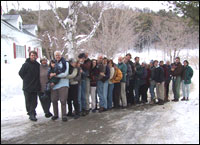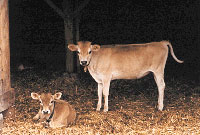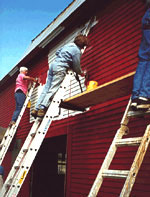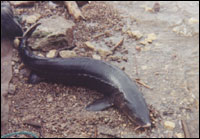Some years ago, I was part of a group that set out to create a community where we could work toward living with less impact on the environment. One of the first steps we took was to write down a list of principles to guide us as we worked to turn our vision into reality. At the top of the list were “community” and “sustainability.” (The others, if you’re curious, were “unity,” “beauty,” and “equity.”)

The village people: Cobb Hill community members.
Photo: Cobb Hill Cohousing.
As I was one of the chief drafters of these principles, I took them very seriously. When newcomers wanted to know what we were up to, I would explain our principles one by one. Community, I used to say, has to do with how we treat each other. Sustainability has to do with how we treat the Earth.
Now, seven years later, we have moved beyond words on a page to a real place that we call Cobb Hill. Here, 22 families share a farm, common meals, childcare, music, a wood-burning heating system, cheese-making, syrup-making, haymaking, and, now and then, quiet cups of tea. Now that I’m living in this messy, wonderful reality rather than that orderly statement of principles, I don’t see the distinctions between sustainability and community quite as clearly as I once did.
Here’s one example. We live about 20 minutes by car from the nearest big town, a drive my family once made weekly for groceries. Knowing plenty about greenhouse emissions and climate change, we weren’t happy with that situation, but we had no other practical options.

Hazel and Willow, part of the family.
Photo: Cobb Hill Cohousing.
Then our community began to cohere. Dana moved in with her chickens, so fresh eggs were always available. Steven and Kerry began milking their cows, so we had fresh milk once a week. We formed a buying co-op, so that once a month we could order boxes of toilet paper, sacks of flour, and jars of spices, all of which were delivered by truck and divvied up among us. Then a group began making cheese and selling it alongside the eggs and milk. We started sharing meals three nights a week. Now, a few times a month, each family cooks for 20 to 30 people; the other nights we do no shopping, no cooking, and no dishes.
The other day, we realized that our family rarely drives to town to buy groceries anymore. A shopping list slowly accumulates on our refrigerator door, and occasionally, when we are out for some other reason, we stop in at the grocery store. We probably spend as much time as we did before on procuring our food. But now we are carrying water to the chickens or cooking a stew for the neighborhood instead of strapping the kids in the car and heading off on a shopping expedition. And we burn less fossil fuel in the bargain.
Maybe this idea of a shared farm appeals to you and maybe it doesn’t. Maybe you love cities and are not excited by the idea of reaching under a chicken for your breakfast eggs. My point is not that our little experiment is the only way to live more sustainably or that my shopping-trip dilemma is the most important sustainability problem on the planet.
What I am saying is this: Joining together in community has a way of opening up unexpected opportunities for sustainability. What we cannot manage individually, we can often achieve collectively. My family could never manage cows, chickens, and cheese on our own; likewise, the owners of each of these small-scale enterprises would be struggling without the community members who share in the ownership and upkeep of our farm. Whether it is a city block reclaiming a park or a community of nations signing a treaty, some of our most powerful options for lessening individual environmental impact require collective action. Now more than ever, we need to draw upon the power of community to protect the planet.

Painting the town red, one barn at a time.
Photo: Cobb Hill Cohousing.
Of course, creating community doesn’t happen effortlessly, and it cannot happen without relinquishing some autonomy. A lot of decisions most families make on their own require the agreement of others in my community. What time should the common meal be served? Families with small children prefer 5:30, but the people milking cows are not finished until 6:30. Should we replace the barn roof? Maybe — but that means money not spent on other projects. Can cats roam free? They are miserable inside, but they kill songbirds. You get the picture: Community living requires a lot of dialogue and a lot of compromise.
I won’t claim that it’s always easy or that I’ve never fantasized about moving to my own little farm at the end of a long, empty road. Still, the give-and-take is a minor inconvenience, not a deep sacrifice. And it is a price I am grateful to pay for the chance to share in this beautiful farm and participate in more sustainability experiments than I could in 10 lifetimes of solitary living.
I’ve been making the case that living in community makes sustainability easier, but it is also important to say that working together towards sustainability builds community. Weeding raspberries with a neighbor last fall, I heard amazing stories of childhood dreams and adventures. Watching a newborn lamb stagger to its feet encircled by a group of my neighbors, I watched faces open and soften in a way that rarely happens during our meetings. In the day-to-day living and working we do together, I see new dimensions of the people of this community. And the more I see of their hopes, their dreams, and their vulnerabilities, the easier it becomes to stick it out and work together during those conversations about roofs and cats and dinner schedules.
Community fosters sustainability. Working together towards sustainability builds community. Far from the separate goals I once believed them to be, community and sustainability are two elements of one whole fabric. They rise and fall together. The more we step into choices where both are rising — and the more we can invite others to step in beside us — the healthier our world and its people will be.


